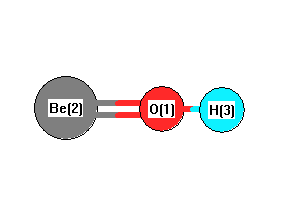Jump to
S1C2
Energy calculated at QCISD(T)=FULL/cc-pVTZ
| | hartrees |
|---|
| Energy at 0K | -90.443159 |
| Energy at 298.15K | -90.442883 |
| HF Energy | -90.136297 |
| Nuclear repulsion energy | 17.506438 |
The energy at 298.15K was derived from the energy at 0K
and an integrated heat capacity that used the calculated vibrational frequencies.
Geometric Data calculated at QCISD(T)=FULL/cc-pVTZ
Point Group is Cs
Cartesians (Å)
| Atom |
x (Å) |
y (Å) |
z (Å) |
|---|
| O1 |
0.048 |
-0.376 |
0.000 |
| Be2 |
0.048 |
1.025 |
0.000 |
| H3 |
-0.582 |
-1.087 |
0.000 |
Atom - Atom Distances (Å)
| |
O1 |
Be2 |
H3 |
| O1 | | 1.4011 | 0.9493 |
Be2 | 1.4011 | | 2.2032 | H3 | 0.9493 | 2.2032 | |
 More geometry information
More geometry information
Calculated Bond Angles
| atom1 |
atom2 |
atom3 |
angle |
|
atom1 |
atom2 |
atom3 |
angle |
| Be2 |
O1 |
H3 |
138.419 |
|
Electronic energy levels
Charges, Dipole, Quadrupole and Polarizability
Jump to
S1C1
Energy calculated at QCISD(T)=FULL/cc-pVTZ
| | hartrees |
|---|
| Energy at 0K | -90.442901 |
| Energy at 298.15K | |
| HF Energy | -90.135428 |
| Nuclear repulsion energy | 17.712043 |
The energy at 298.15K was derived from the energy at 0K
and an integrated heat capacity that used the calculated vibrational frequencies.
Geometric Data calculated at QCISD(T)=FULL/cc-pVTZ
Point Group is C∞v
Cartesians (Å)
| Atom |
x (Å) |
y (Å) |
z (Å) |
|---|
| O1 |
0.000 |
0.000 |
0.351 |
| Be2 |
0.000 |
0.000 |
-1.025 |
| H3 |
0.000 |
0.000 |
1.293 |
Atom - Atom Distances (Å)
| |
O1 |
Be2 |
H3 |
| O1 | | 1.3759 | 0.9422 |
Be2 | 1.3759 | | 2.3181 | H3 | 0.9422 | 2.3181 | |
 More geometry information
More geometry information
Calculated Bond Angles
| atom1 |
atom2 |
atom3 |
angle |
|
atom1 |
atom2 |
atom3 |
angle |
| Be2 |
O1 |
H3 |
180.000 |
|
Electronic energy levels
Charges, Dipole, Quadrupole and Polarizability
